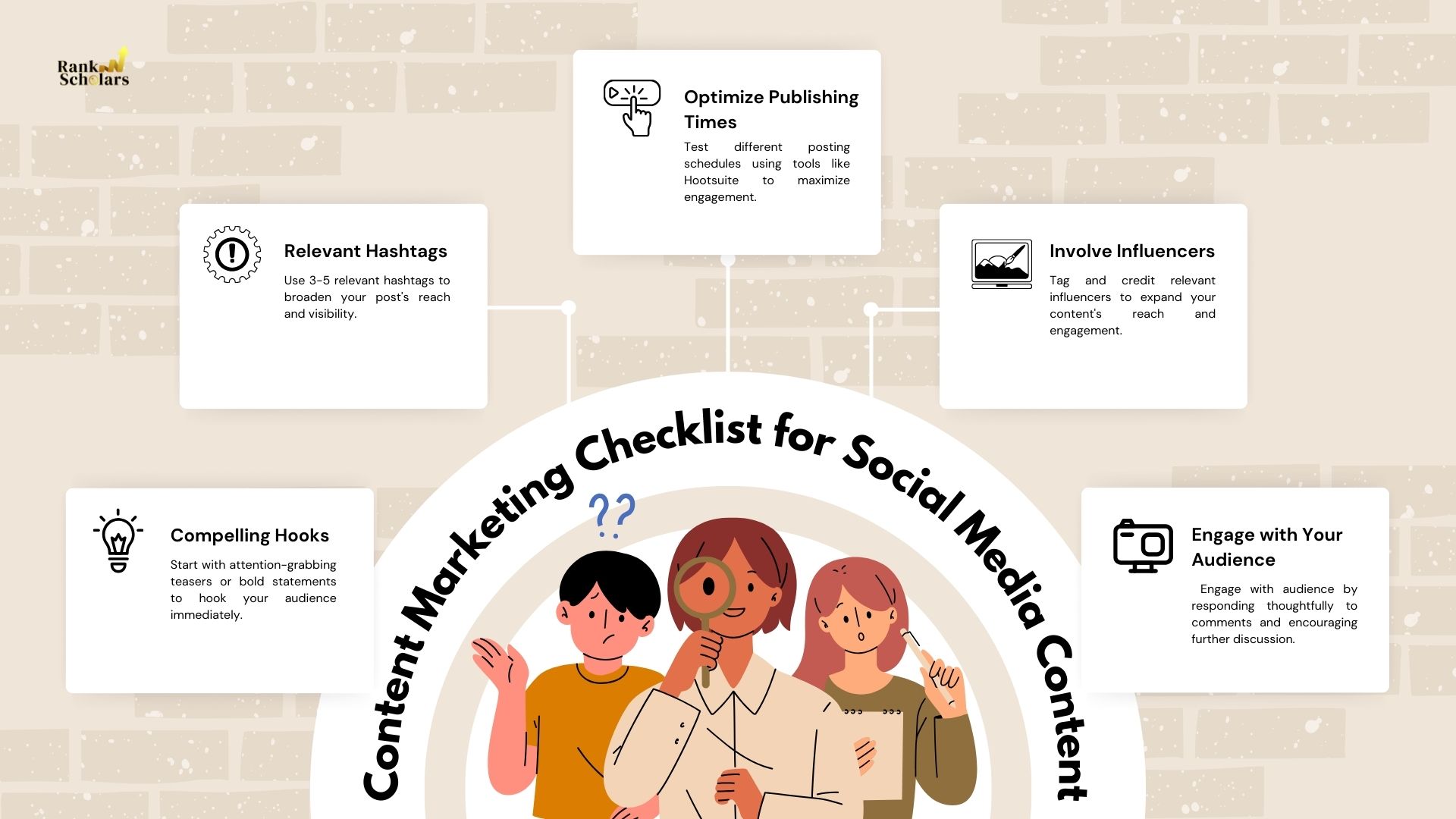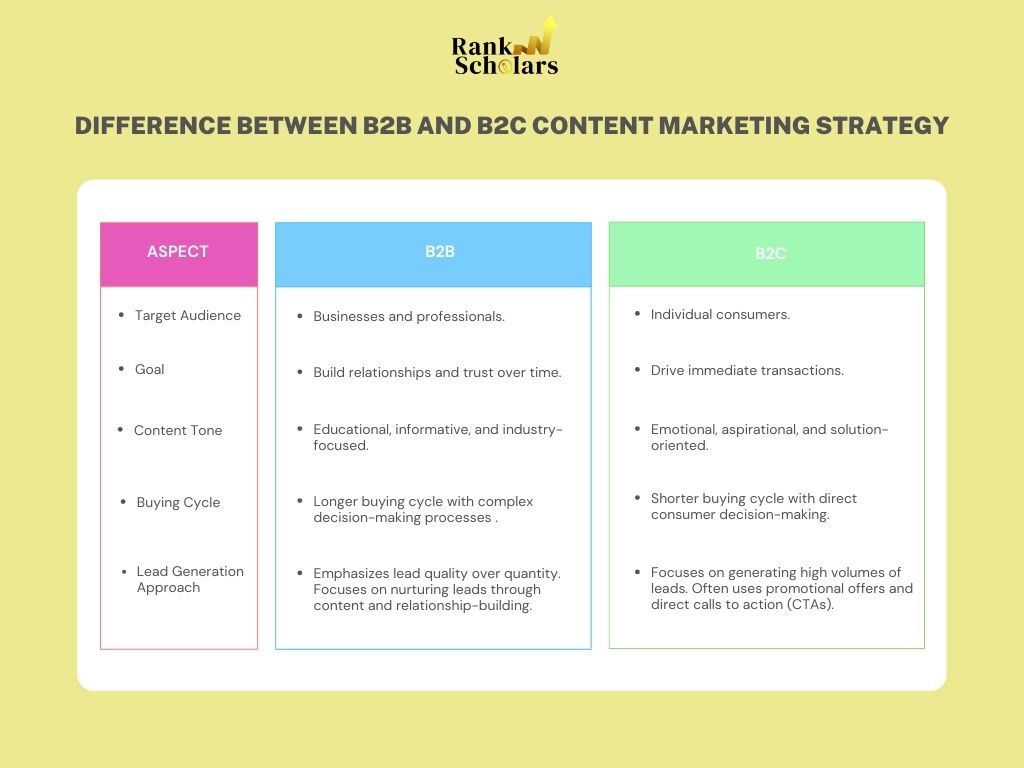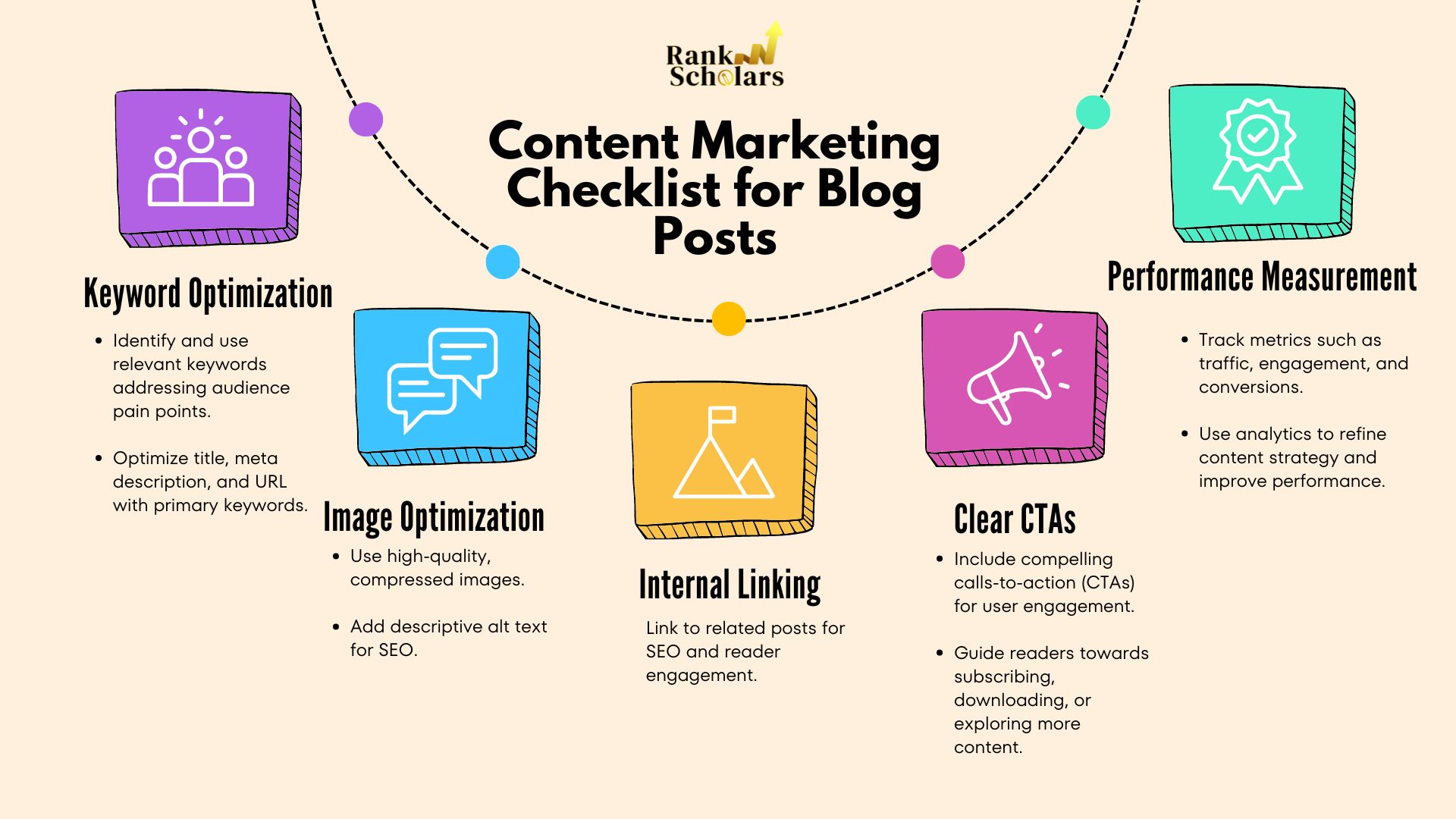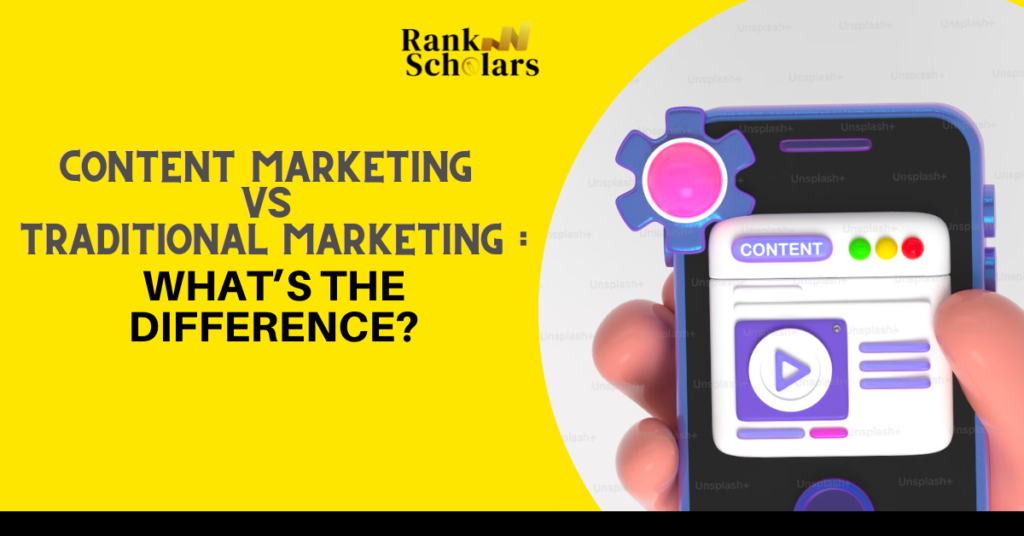Are you struggling to create a content marketing strategy that resonates with your audience? Do you find yourself overwhelmed by the endless tasks and need help figuring out where to start? You’re not alone. Many marketers face these challenges.
You might have seen your competitors seem to have a constant stream of engaging content whereas, for you, some of your content goes viral while other pieces fall flat. Here’s the secret– it all lies in a well-structured strategy.
In this blog post, we’ve explained the ultimate content marketing strategy checklist for you to easily adapt to the complex world of content marketing.
We promise you that this content marketing strategy checklist will provide actionable insights so you’ll achieve your marketing goals. So let’s dive in.

Steps to Develop an Ideal Content Marketing Strategy
You can create an effective content marketing strategy by following a structured approach. Think of it as a roadmap to guide you from where you are now to where you want to be. With this, you can ensure every piece of content you produce serves a purpose and resonates with your target audience.
Here’s how to get started:
Learn Content Marketing Basics
The first step is to understand the foundational principles of content marketing. It’s obvious that content marketing isn’t just about creating and publishing content, it includes some factors such as audience personas, content types, and distribution channels.
This knowledge becomes the backbone of your strategy, and it ensures that you can make decisions that align with your business goals. You’ll be able to develop an effective content marketing strategy by
- understanding your audience,
- diversifying your content types,
- optimizing your content for search engines, and
- staying updated with industry trends and best practices.
Get to Know Your Audience
You need to have a clear understanding of your audience to create a successful content marketing strategy. Who are they? What are their interests, pain points, and aspirations?
You can start by asking the following questions to learn more of these insights:
- What demographic does your product or service appeal to the most?
- Are there specific challenges or desires your audience frequently discusses or searches for online?
- On which social media platforms do they spend the most time?
Conduct surveys, analyze social media demographics, and study data, to craft content that resonates with them on a personal level. Remember, getting to know your audience is an ongoing process and it evolves over time.
Gather feedback, analyze data to refine your understanding, and adapt your content strategy accordingly.
Devise A Content Marketing Strategy
To ensure that your content achieves its intended goals, you need to create a content marketing strategy. But where do you start? How do you craft a plan that aligns with your brand’s objectives and resonates with your target audience?
First, begin by clearly defining your goals. With specific, measurable goals you can track your progress and make changes at times, if needed. For this ask yourself:
- What do you want to achieve with your content?
- Is it increased brand awareness, lead generation, or customer retention?
- Will you focus on blog posts, videos, social media updates, or a mix of these?
Plan a content calendar to ensure consistent publishing. This calendar should include deadlines, responsible parties, important dates, events, and distribution channels.
Finally, analyze your results. Review your content regularly to know what’s working and what needs improvement.
Find Content Topic Ideas
Now that you have a strategy, it’s time to find the right content topic. But here’s the truth, it’s not an easy process. You might find yourself stuck, staring at a blank screen, not sure of what your audience wants to read or watch. Here’s a simple approach:
Conduct keyword research to discover what topics are trending in your industry. Consider using tools like Google Trends, Ahrefs, and SEMrush.
Check on what your competitors are writing about. Examine what topics are performing well. This will give you new ideas and help you find gaps that you can fill. You can also conduct surveys or polls to directly ask your audience what they want to know more about.
Lastly, subscribe to industry newsletters, join relevant online communities, and follow thought leaders in your field. This keeps you informed about the latest developments and topics that your audience might be interested in.
Prepare An Action Plan
To ensure that your content marketing efforts are effective you need a well-crafted action plan. This plan acts as your roadmap, guiding you from the initial state of brainstorming sessions to the final execution and beyond.
Start by outlining your specific goals whether it’s to increase website traffic, boost engagement, or generate leads. Observe the types of content that will best resonate with your audience.
Should you focus on blog posts, videos, social media updates, or a mix of different formats? Determine the key elements that align with your audience’s interests and your business objectives.
Organize a content calendar and map out your content in advance to maintain consistency and stay ahead of deadlines. Regularly review and adjust your strategy based on performance metrics and feedback.
Create Different Types of Content
Different people consume content in different ways, so if you offer a variety of formats you’ll be able to their preferences.
- For blog posts, use in-depth information and storytelling.
- You can use video content to capture attention and explain complex ideas visually.
- With social media updates, you can keep your audience engaged with short, timely content.
- Infographics help with presenting key points in a simple, digestible, and visually appealing manner.
Keep experimenting with different types of content and see what resonates with your audience the most. Note that, variety not only keeps your audience engaged but also enhances your SEO efforts by providing multiple entry points to your website.
Optimize Content For Search Engines
Without SEO even the best content may go unnoticed. It is one of the vital components of content marketing strategy.
Do a thorough keyword research on what terms your target audience might be searching. Once you have your keywords, use them seamlessly into your content.
Place them in strategic locations like titles, headers, meta descriptions, and throughout the body text. But do not overstuff your content with keywords and maintain a natural flow of readability to it.
Optimize images by using descriptive file names and alt tags, and ensure your site is mobile-friendly and loads within 2-3 seconds.
Structure your content with internal links to guide readers to other relevant pages on your site and external links to authoritative sources, boosting credibility and SEO value. Regularly update your content to keep it relevant and timely.
Promote Your Content
Creating high-quality content is only half the battle, the next step is to ensure it reaches your target audience. And for that, you need to promote your content.
Start by sharing your content across your various social media platforms. Tailor your posts to fit each platform’s style and audience to maximize engagement.
Start by leveraging email marketing, newsletters, special offers, and exclusive content to keep your audience engaged and coming back for more.
Collaborate with influencers and industry experts to amplify your reach by tapping into already established audiences.
Use paid promotion strategically. Invest in pay-per-click (PPC) advertising, sponsored social media posts, or content discovery platforms like Outbrain and Taboola.
Use Content Marketing Tools
With content marketing tools you can maximize the efficiency and effectiveness of your content marketing strategy.
Project management tools like Trello, Asana, or Monday.com can keep your content production organized. These platforms allow you to assign tasks, set deadlines, and track progress.
SEO tools such as Ahrefs, Moz, or SEMrush are a must for keyword research, competitive analysis, and performance tracking. These tools help you identify the best keywords to target, understand your competition, and monitor your search rankings.
Content creation tools like Canva for graphics, Grammarly for editing, and Hootsuite for social media scheduling can save you time and improve quality.
Analytics tools such as Google Analytics provide insights into your content performance, helping you make data-driven decisions.
Analyze Campaign Performance
Evaluating your content marketing campaign’s performance is key to understanding its impact and guiding future efforts. Start by analyzing website traffic, social media engagement, lead generation, or conversion rates.
You can use some of the above-mentioned tools for comprehensive insights into your website’s performance, including visitor behavior and traffic sources.
Social media platforms provide their own analytics, helping you track likes, shares, comments, and follower growth.
It’s crucial to monitor your content’s performance over time. Are your blog posts driving more traffic, or are your videos getting higher engagement?
Use these insights to adapt your strategy, focusing more on successful formats and topics.

Content Marketing Checklist for Blog Posts
The following are the key elements to consider when crafting your blog content:
Identify a Keyword That Fits the Pain Point
Start by identifying the specific pain points your audience faces and then create content addressing those issues. Use relevant long-tail keyword variations by analyzing top-ranking posts for those pain points. With this your content becomes both relevant and optimized for search engines, increasing organic traffic.
For example, if your audience struggles with time management, your primary keyword would be “effective time management tips”.
Optimize Your Title, Meta Description, and URL
Crafting an optimized headline, meta description, and URL can significantly impact your blog’s visibility and click-through rates. Keep titles under 60 characters and meta descriptions under 160 characters, including the primary keyword.
For example, a blog post about productivity might have the title “10 Productivity Tips to Boost Your Efficiency,” with a meta description previewing key takeaways.
Ensure your URL is concise and includes the keyword, like “example.com/productivity-tips.”
Optimize Images
High-quality images enhance your content but can slow down your site. Use image compression tools like Smush to reduce file sizes. Add descriptive alt text to your images to improve SEO and help search engines understand the content.
For instance, an alt text for a productivity chart might read “Productivity tips chart.”
Add Internal Links
Internal linking helps both search engines and readers to find your site. Link to relevant posts to provide additional context and keep readers engaged. Adding internal links improves SEO and enriches the reader’s experience.
For instance, if your post mentions “content marketing strategies,” link to another detailed guide on that topic on that post.
Add a Call to Action (CTA) Button
Guide your readers to the next step in their journey with a clear CTA. For top-of-the-funnel content, ask them to sign up for your newsletter. For more solution-aware readers, prompt them to schedule a demo or start a free trial.
For example, after a post on productivity tips, a CTA might be like, “Sign up for our newsletter for more productivity hacks!”
Content Marketing Checklist for Podcasts
To ensure your podcast reaches a wider audience and engages listeners, you need to optimize and promote it effectively. Here are the five key steps:
Leverage Promotion Techniques
Boost your podcast’s visibility by promoting it across various platforms. Encourage your email list to subscribe, run ads for popular episodes, and share previews on social media.
Collaborate with influencers to introduce your podcast to new audiences. For instance, if you host a marketing podcast, partner with a marketing influencer to cross-promote episodes.
Optimize the Title for Clicks
Crafting an intriguing title can increase episode plays. Include relevant keywords for SEO, but focus on creating titles that entice listeners.
For example, for a podcast on digital marketing strategies, a title like “10 Proven Digital Marketing Strategies to Skyrocket Your Business” can attract more clicks. You can use some headliner tools to generate compelling titles from your episode transcript.
Include Show Notes and a Detailed Description
Showing notes and detailed descriptions improves SEO and provides listeners with a preview of the episode. Include relevant keywords and timestamps for better engagement.
For example, if your episode covers various aspects of content marketing, list the topics with timestamps so listeners can jump to sections of interest.
Ask for Ratings and Reviews During the Episode
Ask listeners to rate and review your podcast to improve its ranking. Explain the importance of reviews and make them engaging.
For instance, you can read reviews in future episodes including the reviewer’s name. This will encourage others to leave reviews as well. Ultimately, it will boost your ranking and build a community around your podcast.
Encourage Engagement on the Platform During the Episode
Engagement signals like shares and likes can enhance your podcast’s visibility. Encourage listeners in every episode to share it with specific people and explain the impact.
For example, suggest they share an episode on leadership tips with their manager, enhancing both engagement and reach.
Content Marketing Checklist for Social Media Content
To maximize your content’s visibility and engagement, follow this comprehensive checklist tailored for social media platforms. Here are some steps that will help you:
Craft a Compelling Hook
Capturing your audience’s attention in the first few milliseconds maximizes engagement on social media. Begin your content with a teaser, a bold statement, or a take that stands out.
For example, start a post with “Most productivity hacks don’t work, but this one does…” to intrigue readers. 90% of your audience will stick to the post till the end.
Include Relevant Hashtags
You might wonder, “Should I even use hashtags anymore?” Well, absolutely!!
Using relevant hashtags can significantly increase the visibility of your posts. Aim to include 3-5 relevant hashtags related to the topic of your post.
For example, if you’re posting about digital marketing, hashtags like #DigitalMarketing, #SEO, and #ContentStrategy can help attract a broader audience. Tools like TagsFinder can help identify popular and relevant hashtags to include.
Test and Optimize Your Publishing Times
The timing of your posts can impact their performance. Use social scheduling tools like Hootsuite to test and optimize your posting schedule. Experiment by posting at different times and track which posts receive the highest engagement.
For example, you might find that your audience is more active in the evening, making it the best time to post.
Tag and Involve Relevant Influencers
Involving influencers in your content can enhance its reach. Tag influencers who are relevant to your content, even if you’re not collaborating directly. Mentioning their ideas and crediting them in your post can encourage them to reshare your content.
For instance, if you reference an influencer’s marketing strategy, tag them, and credit their insights. There’s a possibility that they will engage with your post, eventually introducing you to their huge followings.
Engage with Your Audience
Engaging with your audience can double your engagement rates. Respond to comments on your posts with thoughtful answers and follow-up questions to keep the conversation going.
For example, if a follower comments on your marketing post, respond with additional tips and ask for their opinion on the topic. This interaction signals positive engagement with social media algorithms and strengthens your relationship with followers.

Content Marketing Checklist for Video Content
Here are some checkpoints to ensure your video content is well-optimized for clicks, engagement, and extending watch time:
Optimize Your Thumbnails for Clicks
“Don’t judge a book by its cover”- except for the fact that if the cover doesn’t catch the eye, no one’s going to open the book. The same formula goes for video thumbnails.
Bright, contrasting colors and a consistent style across all your thumbnails attract clicks and build brand recognition. Including your face and conveying emotion can also enhance appeal.
For example, a thumbnail with a surprised expression can intrigue viewers. A/B testing different thumbnails can help you determine which one performs best even after your video is live.
Optimize Your Title for Clicks
Titles should be both intriguing and informative. An engaging title paired with a compelling thumbnail can significantly boost click-through rates. Use keywords relevant to your video’s topic to improve searchability.
For instance, a title like “5 Shocking SEO Tips You Haven’t Heard Before” is likely to attract clicks due to its intriguing nature and keyword relevance. Tools like Ahrefs can help identify trending keywords on YouTube to include in your titles.
Include In-Video CTAs
Effective calls to action (CTAs) encourage viewers to like, subscribe, and engage with your content. For example, “Subscribe for exclusive live Q&A sessions!” adds clear value. Also, include CTAs in your video’s meta description.
Here’s a pro tip: Invite viewers to “unlike” your content if they didn’t enjoy the video. Why? Because it fosters honesty and builds trust.
For instance, saying, “If you didn’t find this helpful, feel free to unlike and leave a comment on how we can improve,” shows a commitment to genuine feedback and audience satisfaction.
Hook Viewers in the First Five Seconds
Hooking viewers in the first five seconds is like trying to impress someone on a first date—you’ve got a tiny window to be interesting. So hook those viewers early, or they’ll swipe faster than you can say “subscribe”! Start immediately with engaging content to grab attention.
For example, begin with a teaser of the most exciting part of the video or quickly outline the key points you’ll cover. Avoid lengthy intros like “ Hi I’m [this], today I’ll talk about [this]” It can cause viewers to lose interest. By captivating viewers right away, you impact your video’s ranking.
Respond to Comments
Engaging with viewers in the comments section boosts your video’s engagement metrics and builds a community around your content. Responding to comments shows viewers you value their input, encouraging further interaction.
For instance, if a viewer asks a question about your video topic, provide a detailed answer. This will improve your video’s visibility and help you understand your audience better, allowing for more tailored content in the future.
Difference Between B2B and B2C Content Marketing Strategy Checklist
The strategies that work for a B2B (Business-to-Business) audience would not resonate with a B2C (Business-to-Consumer) audience. Understanding these differences helps you craft a content marketing strategy that effectively reaches and engages your target audience.
B2B Content Marketing Strategy Checklist
B2B (Business-to-Business) content marketing focuses on building relationships rather than immediate transactions. Your target is businesses, which include the longer buying cycle and complex decision-making process. So your content should be informative and relationship-driven.
Your 2024 B2B content strategy checklist might include
Implementing Marketing Automation:
Using marketing automation tools helps you attract and nurture new leads while keeping your current clients happy.
Creating Business Pages On Social Media:
Establish a presence on professional networks like LinkedIn. Here you can connect with industry leaders, potential clients, and other professionals. Creating and regularly updating your business page on LinkedIn enhances your brand’s visibility and builds credibility.
Enhancing Referral Strategies:
Referrals are a powerful way to generate high-quality leads and build a loyal customer base. Develop a strategy that encourages your clients to refer other businesses to you.
Optimizing Website With Landing Page and CTAs:
Your website is your digital storefront, and first impressions matter. Optimize it with targeted landing pages and compelling calls to action (CTAs) to capture leads effectively.
B2C Content Marketing Strategy Checklist
The primary goal of a B2C (Business-to-Consumer) content marketing strategy is to drive transactions. You need to understand your audience’s pain points and create content that offers solutions and encourages action.
Your 2024 B2C content strategy checklist might include:
Refreshing Website Design:
Make sure your website is not only packed with great content but also super easy to handle. A user-friendly design keeps visitors happy and engaged.
Monitoring Online Reviews and Listing:
Keep an eye on your online reviews and local listings. Regularly checking them helps maintain that positive buzz about your brand.
Enhancing Social Media Efforts:
Utilize social media platforms like Instagram and TikTok. Dive into visuals on Instagram and videos on TikTok to capture more attention and engage with your audience in fun, creative ways.
Reviewing SEO Strategies:
Optimize your content so it’s easy to find on search engines. This boosts your visibility and helps your audience discover your helpful solutions. Ultimately, it will increase your SERP rankings.

By tailoring your content strategy to the specific needs and behaviors of B2B and B2C audiences, you can create more effective marketing campaigns and achieve your business goals.
Why Should You Update Your Content Marketing Plan?
The audience’s preferences and behaviors shift with time. Your strategy, too, needs to be up to date. By keeping your content marketing plan current, you ensure that your content remains engaging and valuable to your target audience.
Search engine algorithms and social media trends evolve continually. Updating your content regularly helps you stay ahead of these changes and it ensures that your content maintains high visibility and search rankings.
Also, your business goals and objectives may change over time. It can be launching a new product, entering a new market, or rebranding, and updating your content marketing plan ensures alignment with your latest business strategies.
Regularly reviewing and updating allows you to analyze the performance of your current content. This continuous improvement cycle ensures that your content marketing efforts are always moving towards better results and higher ROI.
Final Words
Implementing a content marketing strategy requires careful planning and execution. By following this ultimate checklist, you can ensure your content not only reaches but also engages your target audience.
From understanding audience needs to optimizing across platforms and measuring KPI, each step plays a vital role in achieving marketing success.
Through this blog, you have learned about the ultimate content marketing strategy checklistthat will drive growth and establish your brand as a leader in your industry.

Sahanaj is a content writer who is passionate about turning ideas into words that inspire positive change.




